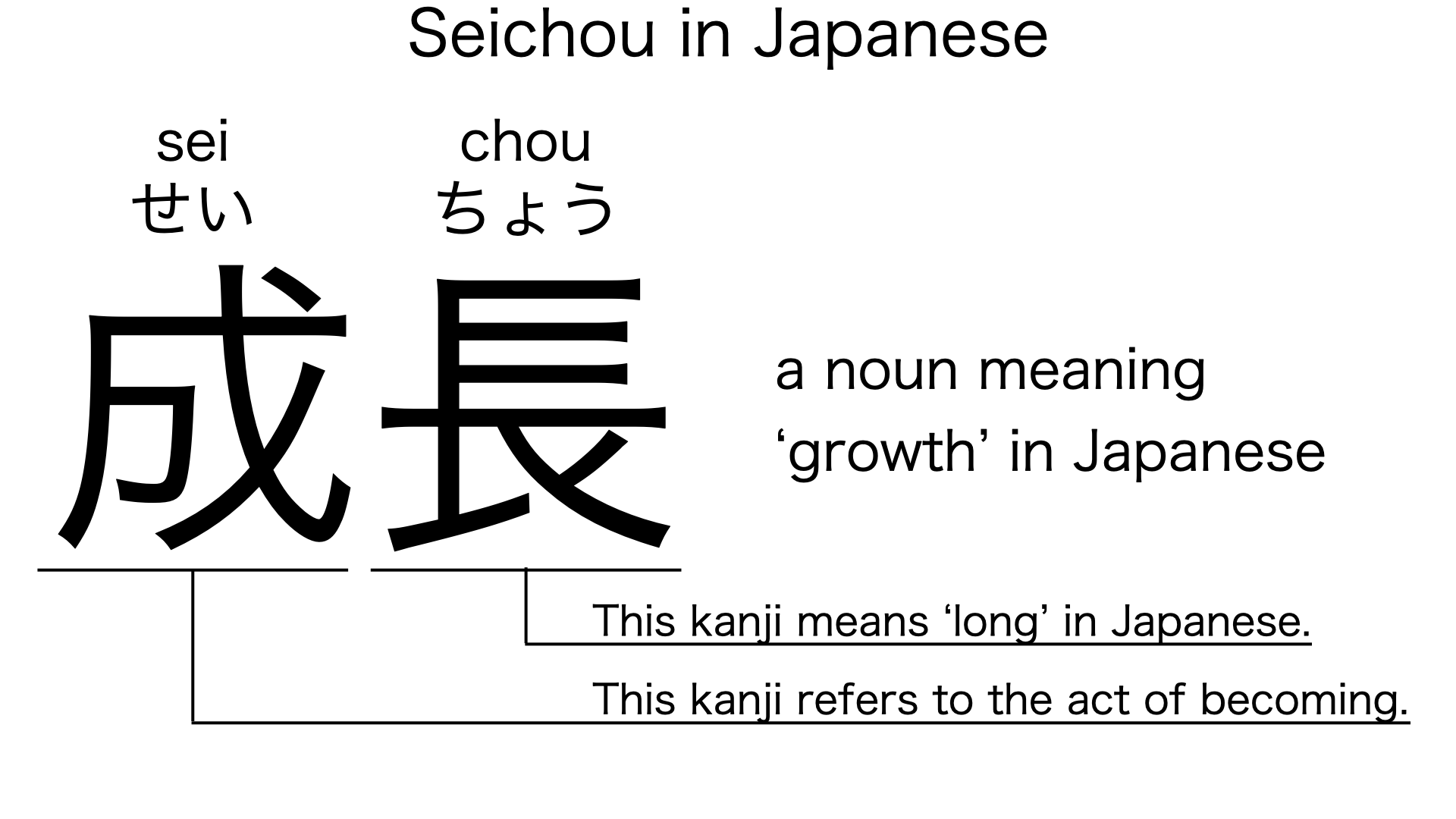What does “seichou” mean in Japanese?
Native speakers say “seishou” normally to mean ‘growth’ in Japanese. Perhaps, some Japanese learners know this word as it is sometimes used in Japanese movies, novels, manga, anime, and the like. In this blog post, however, I will explain this word in detail based on its kanji expression. And also, I will explain how to use it through example sentences. My explanations would help Japanese learners understand “seichou” more clearly. Then, let’s get started!
Contents
Definition and meaning of “seichou”
Let me start with the definition and meaning of “seichou”.
- seichou – 成長 (せいちょう) : a noun meaning ‘growth’ in Japanese.
The definition and meaning are simple and clear. To understand this noun more clearly, however, let me explain its kanji characters in detail, one by one.
What does “seichou” literally mean in Japanese?
The kanji expression of “seichou” consists of the following two kanji characters:
- 成 : a kanji character often used to refer to the act of becoming.
- 長 : a kanji character often used to mean ‘long’ in Japanese.
From these two kanji characters, we can understand that “seichou” literally means ‘becoming long’ in Japanese. This literal interpretation is not completely in line with the actual meaning, but still understandable, I think. When someone or something grows up, it often becomes longer.

When we meet new kanji expressions, we should check their kanji characters in detail to understand their meanings clearly and deeply. In many cases, kanji characters tell us a lot about the meanings of the expressions they form. Actually, here, we could get the better understanding of “seichou” through the detailed kanji check above.
So far, I’ve explained the definition and meaning of “seichou” together with its kanji characters. Then, let me explain how to use it through the example sentences below.
Example #1: how to say “growth” in Japanese
kodomo no seichou wa totemo hayai – 子供の成長はとても早い (こどものせいちょうはとてもはやい)
Children’s growth is so fast.
Below are the new words used in the example sentence.
- kodomo – 子供 (こども) : a noun meaning ‘child’ or ‘kid’ in Japanese. This can also work as plural. Learn more about Japanese plural.
- no – の : a case particle joining two nouns. Normally, the first one can work as a modifier to describe the second. In the example, this works to join “kodomo” and “seichou”. The formed phrase literally means “children’s growth” in Japanese.
- wa – は : a binding particle working as a case marker or topic marker. In the example, this works after “kodomo no seichou” to make the subject in the sentence.
- totemo – とても : an adverb of degree meaning ‘very’, ‘much’, ‘so’, or such in Japanese. In the example, this works in front of “hayai” to emphasize its meaning.
- hayai – 早い (はやい) : an i-adjective meaning ‘fast’ or such in Japanese.
This is a typical usage of “seichou”. In this example, it works together with “kodomo” and “no” to mean “children’s growth” in Japanese.
Example #2: another usage of “seichou”
watashi no musume mo hayaku seichou shi ta – 私の娘も早く成長した (わたしのむすめもはやくせいちょうした)
My daughter grew up fast, too.
Below are the new words used in the example sentence.
- watashi – 私 (わたし) : a pronoun meaning ‘I’ in Japanese.
- no – の : a case particle used after a noun or pronoun to make its possessive case. In the example, this is used after “watashi” to make its possessive case, “watashi no“, which means ‘my’ in Japanese.
- musume – 娘 (むすめ) : a noun meaning ‘daughter’ in Japanese. This can also work as plural.
- mo – も : a binding particle making the subject word or the object word in a sentence with adding the meaning of ‘too’, ‘also’, or ‘as well’. In the example, this works after “watashi no musume” to make the subject in the sentence with adding the meaning of ‘too’.
- hayaku – 早く (はやく) : one conjugation of the i-adjective, “hayai”. In the example, it has been conjugated for the better connection with its following word.
- shi – し : one conjugation of the verb, “suru”, which is often used after a noun to make its verb form. In the example, this is used after “seichou” to make its conjugated verb form, “seichou shi”.
- ta – た : an auxiliary verb used after a verb, adjective, or auxiliary verb to make its past tense form. In the example, this is used after “seichou shi” to make its past tense form, “seichou shi ta”, which can mean ‘grew up’ in Japanese.
This is another typical usage of “seichou”. In this example, it works together with “shi” and “ta” to become the past tense form of the verb, “seichou suru”, which means ‘to grow up’ in Japanese.
Summary
In this blog post, I’ve explained the definition and meaning of “seichou” in detail based on its kanji expression. And also, I’ve explained how to use it through the example sentences. Let me summarize them as follows.
- seichou – 成長 (せいちょう) : a noun meaning ‘growth’ in Japanese. These two kanji characters literally mean ‘becoming long’ in Japanese. This literal interpretation is not completely in line with the actual meaning, but still understandable, I think. When someone or something grows up, it often becomes longer.
Hope my explanations are understandable and helpful for Japanese learners.
Leave a Reply